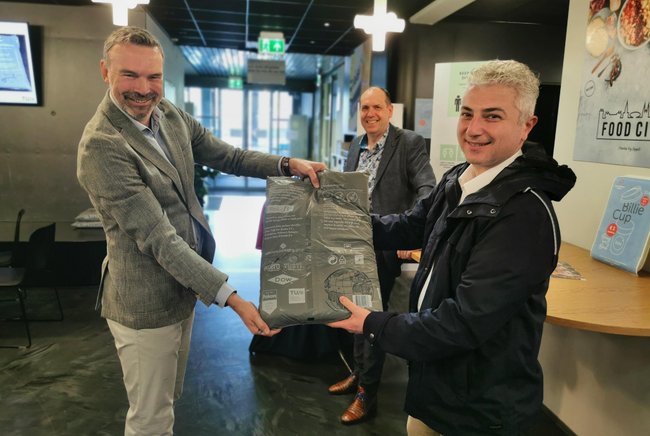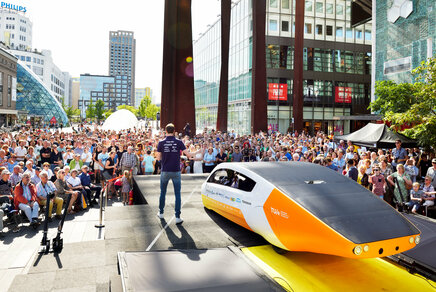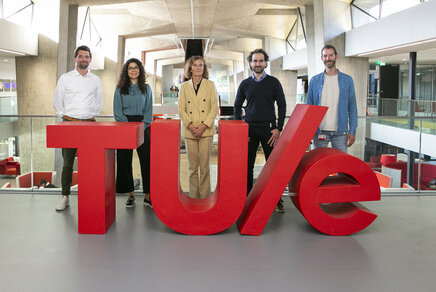Household plastic waste finds new use as compost bag
Project PRoLiFEx converts hard-to-recycle plastic film into high-quality flexible packaging.

About 35 percent of household packaging waste consists of plastic film such as the packaging used for fruit and vegetables, sandwich bags or carrier bags. Recycling this waste is complex, however. A consortium of TU Eindhoven and companies in the packaging materials chain is now showing for the first time how this type of plastic waste can be successfully reused. They have turned it into a new, high-quality packaging material, namely a bag for compost that people use in their gardens. The packaging was recently introduced and distributed on National Compost Day on March 26. Today, these special compost bags were distributed to staff of the TU/e department of Chemical Engineering & Chemistry.
The compost bag is the result of a collaboration between Attero, TUSTI, Pokon Naturado, Oerlemans Packaging Group, EGEN, Dow Benelux BV and TU Eindhoven. Their research into ways of optimizing the recycling of plastic film took shape in the project PRoLiFEx (Postconsumer Recycling of L(L)DPE in Flexible Extrusion).
Uniformly gray bag
The new compost bag has a volume of 25 liters and consists of 65% recycled plastic film and 35% new plastic. There are no bright colors on the packaging, but it is a uniform gray bag with white printing. "And that's intentional," says Jaap den Doelder, TU/e professor of Physical Chemistry of Polymers who works at Dow Benelux BV. "In this way, we wanted to emphasize visually the fact that this is a reused product, in much the same way as you see with toilet paper or garbage bags, for example."
That the collective focused specifically on the compost bag as an application has to do with the strict requirements for the packaging. For example, they have to be much sturdier than a garbage bag, protect the contents well and keep them good for a long time, and be robust enough for storage and use. "We deliberately chose the compost bag to really be able to demonstrate an improvement in viable applications," Den Doelder says.
190 kilotons of waste
Up to now, the reuse of lightweight plastic films has in fact been very limited with about 190 million kilograms of these plastics being thrown away annually – equivalent to more than 10 kilograms per person in the Netherlands. The fact that our waste contains all the different types of packaging makes sorting a difficult task. That's why, until now, the focus has been on reusing heavy, thick packaging. "That quickly results in many kilograms being recycled, they are easier to sort and there is a market for it," says Den Doelder.
Flexible films, however, require specifically different steps and techniques in the recycling phase, according to Den Doelder. "The process from waste to compost bag starts with collection. In this regard, separating the collection of plastic, metal and drinks package waste (PMD) is a good starting point."
"The next step is to sort plastic film material separately," Den Doelder continues. "This is possible, for example, using infrared detection, in combination with sorting by density or by size. As yet, few waste processors are focusing on this portion of PMD waste, which may change as the materials become more reusable."
When these materials enter the processing phase, they are first reduced to flakes, which are then washed to remove contaminants. "In this process, the temperature of the wash water and the possible addition of detergents are interesting parameters to play with," Den Doelder explains. "Extra attention is needed for the washing and drying steps in the process, compared to the processing of hard, rigid plastics. In the final processing step, the material is melted and extruded into new homogeneous granules of reusable PCR (recycled plastic).
New Products
When manufacturing a new product, such as the compost bag, the PCR granules are mixed with granules of new plastic. Den Doelder: "Selecting the appropriate new plastic must be done carefully, so that the mixture and the new film acquire the right properties. The choice of LLDPE with specific properties (density, melting temperature) ultimately helps to determine how quickly the bag can be formed and sealed."
The film is then extruded through a blown film process after which the film is printed. In the final steps, the film is formed into a bag, the bag is filled with compost and closed (sealed). According to Den Doelder, it is one of the first demonstrations of a circular approach for flexible packaging particularly because we take domestic waste as the starting point of the process. "We want this example to inspire and to show that it is possible, if the right focus is there. Whether we really solve the problem of plastic films depends, among other things, on the willingness, technological progress and capacity to sort films and process them further."
Media contact
More on Sustainability



Latest news


